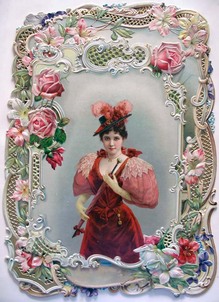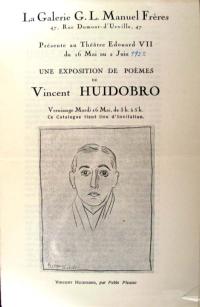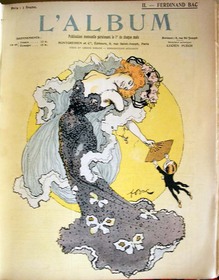
La Galerie G.L. Manuel frères, 47, rue Dumont-d’Urville, 47, présente au Théatre Edouard VII du 16 ma au 2 juin, une exposition de poèmes de Vincent Huidobro([Paris: s.n., Imp. Union), 1922. Graphic Arts (GAX) 2010- in process
In 1916, the Chilean poet Vicente Huidobro (1893-1948) founded a new artistic movement, which he called Creationism. He wrote that a poet shouldn’t just “sing to the rose but make it flower in the poem itself” (Por qué cantáis la rosa, hacedla florecer). Huidobro left Chile and settled in Paris, where he mixed with the Parisian avant-garde, including Pablo Picasso, Juan Gris, Jacques Lipchitz, Joan Miró, and Paul Eluard. In 1921, Huidobro founded the first of several arts journals, this one called Creación (self-published using a family inheritance).
Early in 1922, an exhibition entitled Salle XI opened at Théatre Eduard VII. On the walls were thirteen visual poems by Huidobro, who referred to them as paintings. The exhibition invitation/catalogue (seen here) contains a preface by Maurice Raynal, a portrait of Huidobro by Picasso, and one of Huidobro’s letterpress calligrams titled Paysage (Landscape), dedicated to Picasso.
Folded and laid in was the poster/poem/manifesto Moulin, (first published in Creación) whose lines form the image of a windmill, designed by Robert Delaunay. The text of the poem begins at the center, moves outward with verses on each turning blade, and ends with the line at the bottom of the page concerning grey hair. Not long after this, Huidobro abandoned the idea of writing calligrams such as Paysage and Moulin, and began concentrating on the verbal sequence rather than the visual display of words.
See more: The Poet is a Little God: Creationist Verse by Vicente Huidobro (Riverside, CA: Xenos Books, 1990). Firestone Library (F) PQ8097.H8 A17 1990
One possible translation of Paysage:
In the Evening we will stroll down parallel paths
The moon in which you look at yourself
The tree was higher than the mountain
But the mountain was so wide it projected beyond the earth’s edges
The flowing river contains no fish
Do not play on the freshly painted grass
A song leads the sheep toward the stable


























































Recent Comments